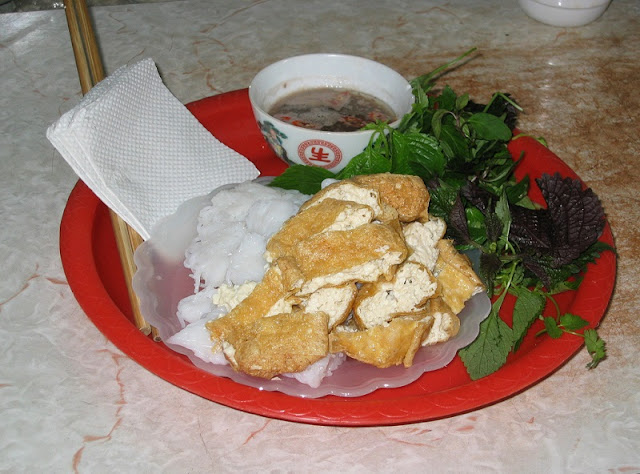Many of Hanoi’s signature dishes, such as bun dau mam tom (fermented shrimp paste with fried tofu and rice vermicelli) or oc nau chuoi dau (snail soup with green banana, fried tofu and perilla leaves), have tofu as the main ingredient.
The soft and white soybean curd is also found in nearly every Vietnamese meal.
Dishes made of tofu are sold abundantly in most Vietnamese markets and made in different regions across the country, but those made in Mo Village, presently known as Mai Dong Village in Hanoi’s Hoang Mai District, are the most delicious, giving rise to the moniker, “Mo Village’s Tofu”.
 |
| Photo by trungnguyen299 |
Legend has it that Tam Trinh, a general during the rule of the Trung Sisters (40-43), introduced the villagers to the method of making tofu, which has been preserved until now. Due to his contribution, the general has been elevated to the status of Totelarry God in the village.
Most Hanoian housewives still prefer using Mo tofu to make dishes as this variety of tofu has a special creamy taste and sweet flavour and is very soft. This is attributed to the water taken from the village’s well to make the curd.
But the distinct taste of this tofu is mainly derived from the sophisticated method of preparation that has been carefully followed by the villagers since their ancestors’ time.
Tofu makers in Mo Village normally wake up at 3am to make fresh tofu for early morning markets.
According to Nguyen Thi Quyen, a resident of the village, choosing the proper soybean is the first crucial step.
“All soybeans of a batch should be the same. Only yellow soybeans with good-looking inner parts are chosen, while the low-quality seeds are removed. The beans must also be washed thoroughly, otherwise the tofu will be dark in colour,” she said.
After having their husks removed, the soybeans are soaked for three to four hours in summer or longer in winters before being ground and mixed with water to produce the first batch of tofu.
 |
| Photo by pixabay |
“The maker has to constantly check the sufficiency of the soybeans and water so that the beans are ground thoroughly,” Quyêen said.
The water is then filtered with a specialised machine. This is the first round. Water continues to be filtered with a special cloth to extract the quintessence of the soybeans. According to Quyen, the more thoroughly the first round of water is filtered, the purer the curd will become.
The decisive step of the quality of tofu is cooking the filtered soybean water, which requires skill and experience. If the water is undercooked, the tofu will not have a sweet taste, and if it is overcooked, it will have a burnt smell.
The properly-cooked soybean water is poured into a huge jar to cool down and then mixed with sour water to create soy curd, which is then pressed into moulds to produce batches of tofu.
 |
| Photo by pxhere |
Making tofu does not require sophisticated cooking or processing. It can be served hot with fermented shrimp paste, fish sauce mixed with onion or simple spices mixed with lime juice - a perfect dish for summer.
Fried tofu is the most popular. After being fried in boiled oil, the tofu gets a crispy and greasy coating, which tastes well with rice or rice vermicelli. Fermented shrimp paste with fried tofu and rice vermicelli has become widely popular and is reasonably priced too.
Hanoians also like their tofu baked. This is best tasted by breaking the tofu into pieces, dipping it into fermented shrimp paste and enjoying it with Vietnamese balm leaves and small pieces of pepper.
Tofu can be simply processed to create simple dishes such as dau sot ca chua (tofu cooked with tomato) or buun dau oc (snail vermicelli with fried tofu). It can also be cooked in a sophisticated way to create fine cuisines, such as dau phu om nam (fried tofu and sautéed shiitake mushrooms, garnished with scallion) or suup dau phu hai san (seafood and tofu soup).
But no matter how it is cooked, Mơ tofu today is a “trade mark” cuisine of Hanoi.-VNS
